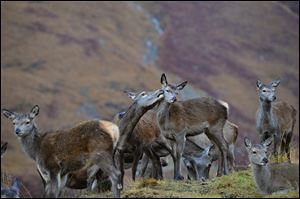
Deer population in U.K.
3/15/2013
Red deer hinds graze in Glen Etive, Scotland. Wildlife biologists say the U.K. has more deer than at any time in the region’s history since the last Ice Age.
Perhaps it is an early chapter in the ruminant version of “The Population Bomb” playing out in the parks and backyards and river bottoms all around us, where there are likely too many deer.
That 1968 book by Paul Ehrlich warned of mass starvation and an upheaval in society if the human numbers continued to grow, and scientific studies on certain deer populations have cautioned about another set of dire circumstances — the damage to fragile ecosystems due to extensive over-browsing, the loss of habitat vital to birdlife, the degradation of native plants and wildflowers, and a spike in deer-auto collisions.
The Cleveland suburbs of Avon Lake, Solon, and Mentor have employed or considered the use of highly regulated hunts to reduce deer populations within those communities, while Cleveland Metroparks has used sharpshooters to try and reduce the damage an exploding deer herd does to the ecosystem there.
Ottawa Hills has faced the same issues, while East Harbor State Park near Marblehead has used a special archery hunt for hunters with disabilities to thin its deer herd.
This is not a problem unique to certain areas of the United States, where game management is as refined as anywhere on the planet. Our neighbors in the United Kingdom have a much bigger crisis on their hands.
A recent study laid out in the “Journal of Wildlife Management” stated that it might be necessary to harvest at least half of the estimated 1.5 million deer in the U.K. to provide for population stability and to slow the destruction the deer herd is doing to the woodlands and bird habitat.
There are six species of deer present in the U.K., according to The British Deer Society, a conservation-minded organization. Red deer and Roe deer are the only native species, according to the group, with Fallow deer likely introduced by the Normans or Romans, and three species from Asia — Reeve’s muntjac, Chinese water deer, and sika brought to the U.K. near the end of the 19th century.
The research and deer population study, conducted by the University of East Anglia, acknowledges the important role of native deer in the overall wildlife picture in the British countryside, but stresses the threat that unchecked deer populations pose to the balance in the woodlands ecosystem. Wildlife biologists say the U.K. has more deer than at any time in the region’s history since the last Ice Age.
“Trying to control deer without a robust understanding of their true numbers can be like sleepwalking into disaster,” Dr. Kristin Waber, who worked on the study, said in a news release from the university.
With no natural predators present, deer numbers have continued to expand, even in some areas where professionally managed culling operations have removed thousands of deer. Waber said the culls did not even offset the reproduction numbers in the deer herds, and that she expects this same phenomenon is taking place throughout much of the country.
Others have pointed to a decrease in hunting, plus the ability of some deer species to be highly adaptive in urban areas, preserves, and riparian corridors. Waber mentioned that the British are not alone as they confront the environmental impact of expanding deer numbers.
“In recent years, people have become more and more concerned about the impacts deer are having in North America, Britain, and elsewhere in Europe,” she said. “Increasing deer populations are a serious threat to biodiversity — particularly impacting on woodland birds such as migrant warblers and the nightingale.”
Dr. Paul Dolman from the East Anglia school of Environmental Science, which led the research in the study, emphasized that a cull should be used as a harvest tool to bring venison to the table, not to waste the resource.
“In a way, [venison] provides a sustainable food source where you know where it comes from, you know it is ethically sourced, you know it is safe to eat, and that puts food on people’s tables,” he said. “As much as I love deer, to be a meat eater but then to object to the culling and harvesting of deer seems to be inconsistent.”
The British Deer Society, in a statement posted on its Web site last week, said calling for a 50 percent cull of the deer herd in the U.K. was “not well justified” and questioned the science used to reach the study’s conclusion.
“The British Deer Society acknowledges that there are areas within the U.K. where there are far too many deer,” the statement said, but it also suggested that the areas studied by the East Anglia group were not “representative of the wider countryside.”
In a subsequent interview with the Guardian newspaper, Dolman said his figures were “hypothetical examples.”
“We don’t know how many deer there are in this country, and that is the real problem I was trying to get over,” Dolman said. “We have found that our knowledge of deer population densities is much poorer than we previously thought.”
In his report, Dolman stressed the damage the existing deer population has inflicted on the landscape, and the habitat of other wildlife.
“We know deer are eating out the ... vegetation of important woodlands, including ancient woodlands,” he said. “There is evidence that deer reduce the number of woodland birds - especially some of our much loved migrant birds ... We have a problem.”
Contact Blade outdoors editor Matt Markey at: mmarkey@theblade.com or 419-724-6068.